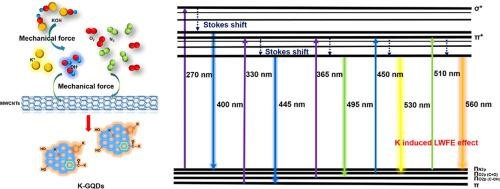Date:2022-04-01
Associate Professor Zhou Benqing and his team, with Zhou Benqing as the first corresponding author and Shantou University as the first communication unit published in the journal of Chemical Engineering Journal, 2022, 440, 135800 (if = 13.273 JCR-Q1) published the research paper "laser size homogeneous and doping degree controlled potassium doped graph quantum dots by mechanochemical reaction". https://www.sciencedirect.com/science/article/pii/S1385894722013006.
For a long time,the electron modification effects of alkaline metal on graphene and carbon nanotubes have been widely studied by numerous research groups, but never been explored on graphene quantum dots (GQDs), owing to the limitation of synthetic method. Here, this team presented a dopant controllable mechanochemical procedure for potassium-doped GQDs (K-GQDs) preparation: by shifting the synthetic parameters, the doping degree of K can be effectively adjusted with little change of the crystal lateral size. Physiochemical characterizations revealed that the K+ tended to form chemical bonds with carbonyls, pyrrolic and graphic nitrogen-the so-called Lewis acid. Spectral techniques further confirmed the K dopants on the as-mentioned sites could reduce the blue fluorescence that related to the intrinsic state, but enhance the yellow and orange florescence caused by the increase of electron radiative transition rate between π*-nO2p and π*-nN2p simultaneously. Moreover, the K-GQDs displayed benign cytocompatibility and cellular fluorescence imaging performance. Herein, we propose the K+ may play a role in enhancing long wavelength florescence intensity of GQDs, which makes the K-GQDs a promising probe for bioimaging. To our knowledge, this is the first time to report the successful preparation of GQDs chemically doped by K element and reveal the long wavelength florescence enhancement (LWFE) effect of K doping. Our findings suggest that the alkaline metal doping may be an effective technique to overcome the florescence wavelength limitations of GQDs in bioimaging applications.
